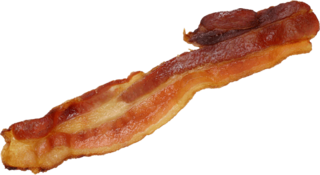
Bacon is a type of salt-cured pork made from various cuts, typically the belly or less fatty parts of the back. It is eaten as a side dish, used as a central ingredient, or as a flavouring or accent. Regular bacon consumption is associated with increased mortality and other health concerns.
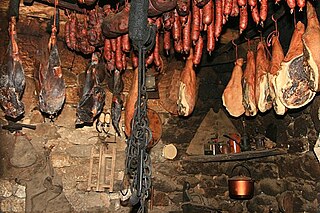
Smoked meat is the result of a method of preparing red meat, white meat, and seafood which originated in the Paleolithic Era. Smoking adds flavor, improves the appearance of meat through the Maillard reaction, and when combined with curing it preserves the meat. When meat is cured then cold-smoked, the smoke adds phenols and other chemicals that have an antimicrobial effect on the meat. Hot smoking has less impact on preservation and is primarily used for taste and to slow-cook the meat. Interest in barbecue and smoking is on the rise worldwide.

A lardon, also spelled lardoon, is a small strip or cube of fatty bacon, or pork fat, used in a wide variety of cuisines to flavor savory food and salads. In French cuisine, lardons are also used for larding, by threading them with a needle into meats that are to be braised or roasted. Lardons are not normally smoked, and they are made from pork that has been cured with salt.

Gravlax or graved salmon is a Nordic dish consisting of salmon that is cured using a mix of salt, sugar and dill. It is garnished with fresh dill or sprucetwigs and may occasionally be cold-smoked afterwards. Gravlax is usually served as an appetizer, sliced thinly and accompanied by hovmästarsås, dill and mustard sauce, either on bread or with boiled potatoes.
Serbian cuisine is a Balkan cuisine that consists of the culinary methods and traditions of Serbia. Its roots lie in Serbian history, including centuries of cultural contact and influence with the Greeks and the Byzantine Empire, the Ottomans, and Serbia's Balkan neighbours, especially during the existence of Yugoslavia. Historically, Serbian food develops from pastoral customs that involved the keeping of sheep in mountain highlands, in a climate and regional context that favoured animal husbandry over vegetable farming; Serbian food is therefore traditionally richer in animal products and basic grains—corn, wheat and oats—than fresh vegetable dishes. Following the abandonment of widely practiced pastoral lifestyles, Serbian food emerged through the Middle Ages heavily dependent not on lamb or mutton, but on the keeping of pigs for the annual cull and the production of various cured meats, such as sausages, bacon and ham products.
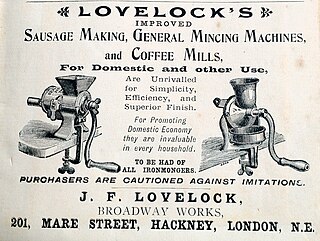
The origins of meat preservation are lost to the ages but probably began when humans began to realize the preservative value of salt. Sausage making originally developed as a means to preserve and transport meat. Primitive societies learned that dried berries and spices could be added to dried meat. The procedure of stuffing meat into casings remains basically the same today, but sausage recipes have been greatly refined and sausage making has become a highly respected culinary art.

Charcuterie is a branch of French cuisine devoted to prepared meat products, such as bacon, ham, sausage, terrines, galantines, ballotines, pâtés, and confit, primarily from pork.
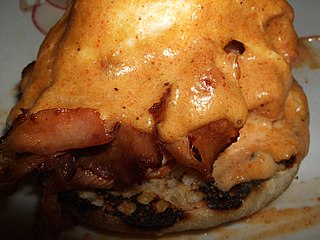
Tasso ham is a smoked, spiced, and cured meat, a specialty of south Louisiana cuisine. In this case "ham" is a misnomer since tasso is not made from the hind leg of a hog, but rather the hog's shoulder. This cut is typically fatty, and because the muscle is constantly used by the animal, has a great deal of flavor. The shoulder, which will weigh 7 to 8 pounds, is sliced across the grain into pieces about 3 in thick. These are dredged in a salt cure, which usually includes sodium nitrite and sugar. The meat is left to cure briefly, only three or four hours, then rinsed, rubbed with a spice mixture containing cayenne pepper and garlic, and hot-smoked until cooked through.

'Nduja is a spicy, spreadable pork sausage from the Calabria region of Italy. It derives from andouille, a French kind of sausage introduced to southern Italy by the Angevins.
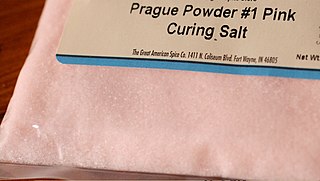
Curing salt is used in meat processing to generate a pinkish shade and to extend shelf life. It is both a color agent and a means to facilitate food preservation as it prevents or slows spoilage by bacteria or fungus. Curing salts are generally a mixture of sodium chloride and sodium nitrite, and are used for pickling meats as part of the process to make sausage or cured meat such as ham, bacon, pastrami, corned beef, etc. Though it has been suggested that the reason for using nitrite-containing curing salt is to prevent botulism, a 2018 study by the British Meat Producers Association determined that legally permitted levels of nitrite have no effect on the growth of the Clostridium botulinum bacteria that causes botulism, in line with the UK's Advisory Committee on the Microbiological Safety of Food opinion that nitrites are not required to prevent C. botulinum growth and extend shelf life..

Curing is any of various food preservation and flavoring processes of foods such as meat, fish and vegetables, by the addition of salt, with the aim of drawing moisture out of the food by the process of osmosis. Because curing increases the solute concentration in the food and hence decreases its water potential, the food becomes inhospitable for the microbe growth that causes food spoilage. Curing can be traced back to antiquity, and was the primary method of preserving meat and fish until the late 19th century. Dehydration was the earliest form of food curing. Many curing processes also involve smoking, spicing, cooking, or the addition of combinations of sugar, nitrate, and nitrite.

Michael Carl Ruhlman is an American author, home cook and entrepreneur.
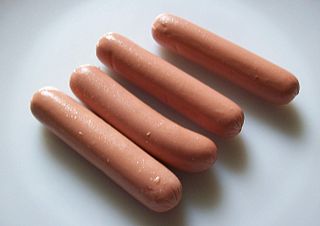
A vegetarian hot dog is a hot dog produced completely from non-meat products. Unlike traditional home-made meat sausages, the casing is not made of intestine, but of cellulose or other plant-based ingredients. The filling is usually based on some sort of soy protein, wheat gluten, or pea protein. Some may contain egg whites, which would make them unsuitable for a lacto-vegetarian or vegan diet.
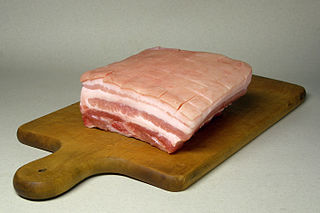
Pork is the culinary name for the meat of the pig. It is the most commonly consumed meat worldwide, with evidence of pig husbandry dating back to 5000 BCE.

A Bacon Explosion is a pork dish that consists of bacon wrapped around a filling of spiced sausage and crumbled bacon. The American-football-sized dish is then smoked or baked. It became known after being posted on the BBQ Addicts blog, and spread to the mainstream press with numerous stories discussing the dish. In time, the articles began to discuss the Internet "buzz" itself.

The Bacon Cookbook: More than 150 Recipes from Around the World for Everyone's Favorite Food is a cookbook on bacon by James Villas. It was published by Wiley in 2007. Villas is a former food editor for Town & Country magazine, and The Bacon Cookbook is his 15th book on food. He notes on the book's jacket that he was "beguiled by bacon since he was a boy." He describes the appeal of bacon in the book's preface, and in the introduction recounts the history of the product, as well as its variations from different locations internationally. Chapters are structured by type of recipe and food course, and in total the book includes 168 recipes.

D’Artagnan (D'Artagnan, Inc., also known as D'Artagnan Foods) is a food seller and manufacturer of beef, pork, lamb, veal, pâtés, sausages, smoked and cured charcuterie, all-natural and organic poultry, game, free-range meat, foie gras, wild mushrooms, and truffles.

Salumeria Biellese is a historic Italian deli at 8th Avenue and 29th Street in the Chelsea neighborhood of Manhattan in New York City. It was established in 1925.


















